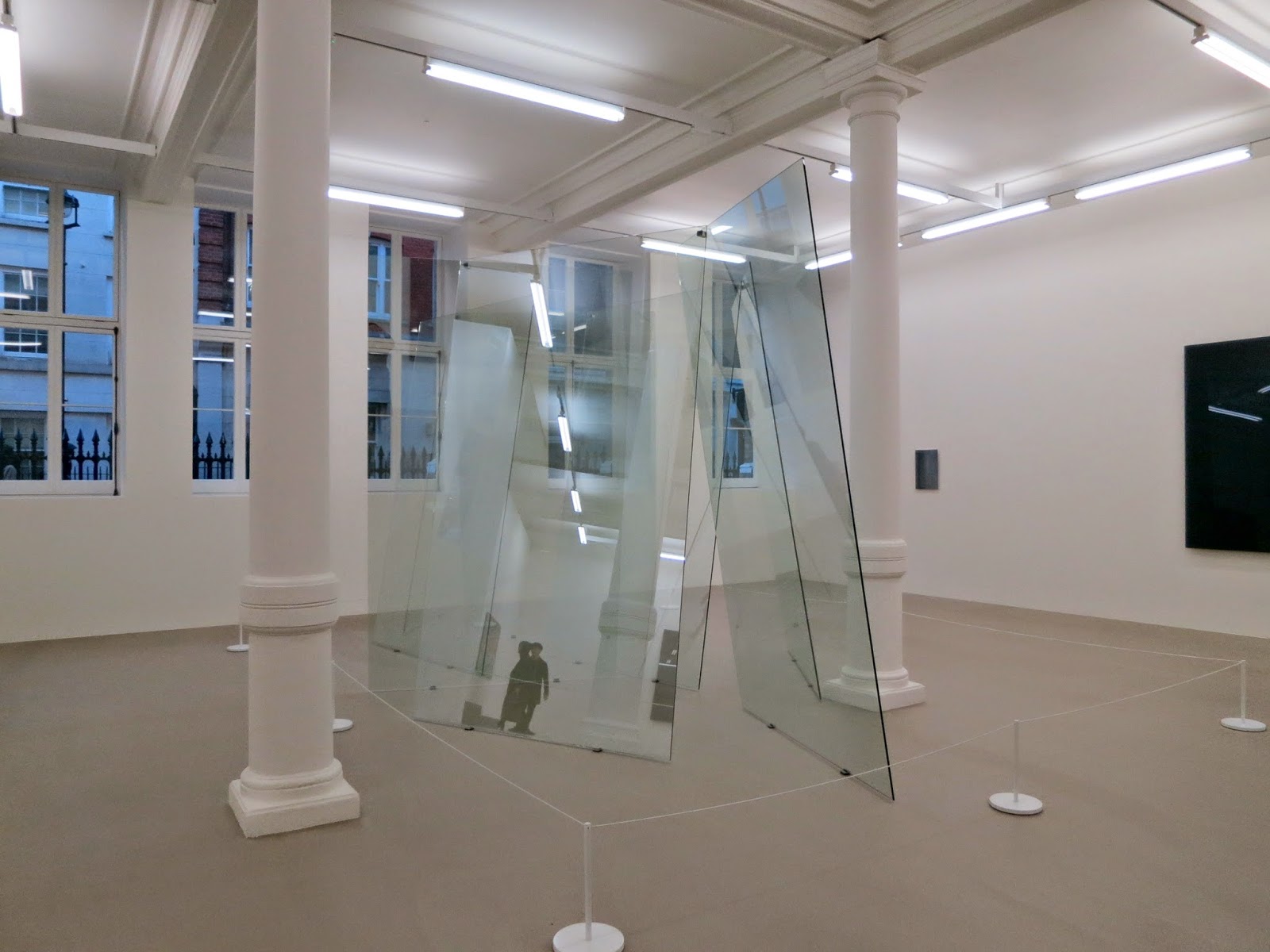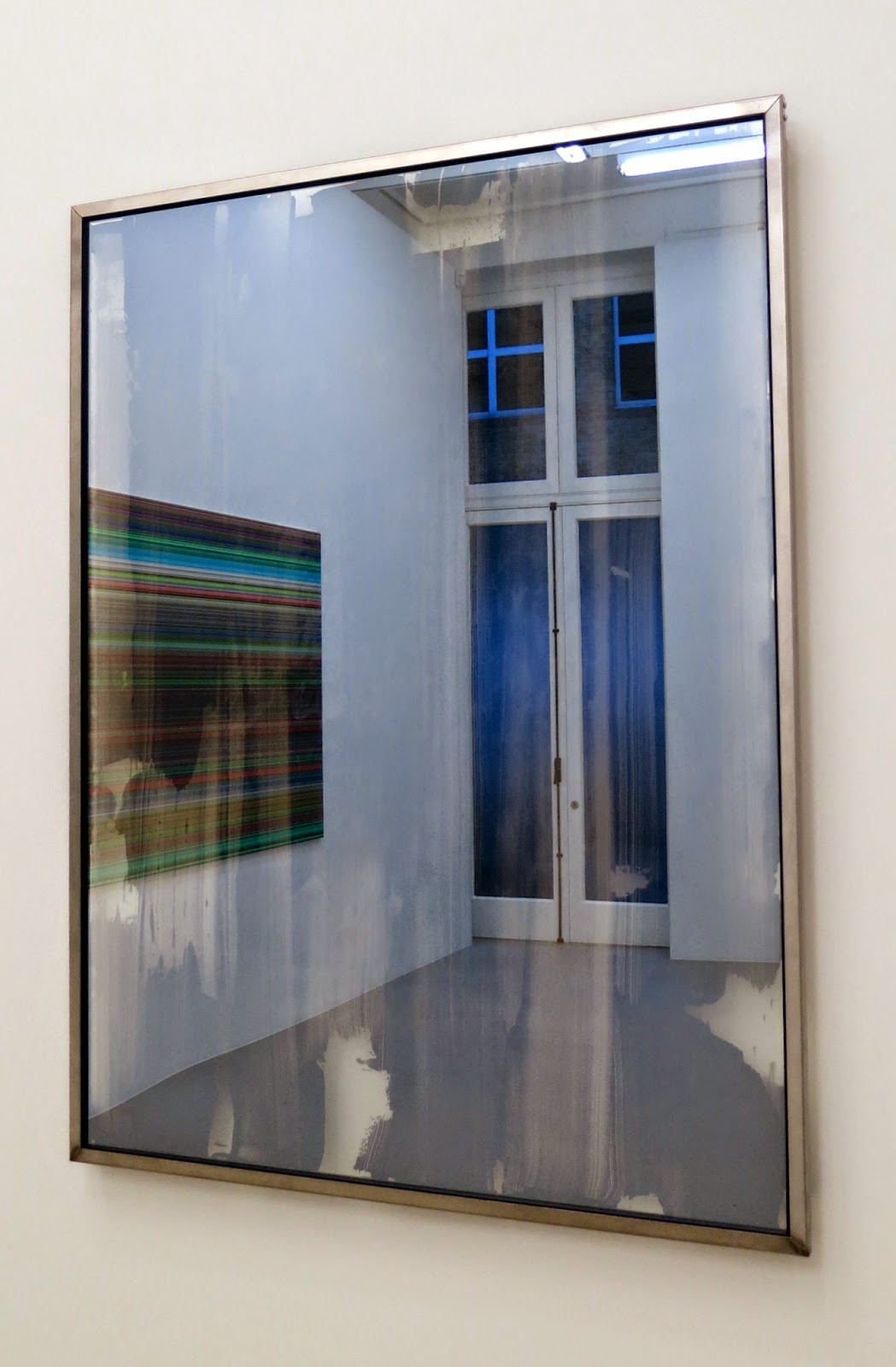Gerhard Richter at the Marian Goodman Gallery, 5-8 Lower John Street, London.
This is a new gallery in London and the Gerhard Richter is their inaugural exhibition. I had been looking forward to seeing this exhibition for a long time, as I am an admirer of Richter's work.
He has produced an enormous variety of works moving between abstraction, landscape, photo-painting, monochrome paintings of his family, portraiture and history painting, which includes those of the Baader Meinhoff group. You can see more of his work here .

I loved the building too.
House of Cards
Seven sheets of glass propped against each other at angles that produce the illusion of shards slicing through, layering and dislocating light, reflecting not just the strip lights overhead, but the paintings on the walls and the viewers too. All edges and transparent planes, the sheets of glass reach towards the ceiling and are held together by small steel clamps.
This work, like Richter's other glass installations, recalls a trip he made to Greenland in 1972, initially inspired by Friedrich but during which he soon abandoned that romanticism for a fascination with the formal qualities of icebergs.
Doppelgrau (Double Grey)
Four large diptychs, each juxtaposing two different shades of grey paint behind glass. No mark-making, instead, reflection. Reflection of the architectural space and the viewers. Each diptych is mounted to a support that projects the picture plane forward off the wall towards the viewer, hovering in space, thus helping the reflection. It's impossible to look more closely at the greys, the reflections keep you at bay.
This series continues Richter's nearly 50-year engagement with grey monochromes, an enduring fascination: 'Grey is the epitome of non-statement'.
These are really like mirrors, reflecting the space, the paintings, the viewers
Forty years ago, Richter says, he built a narrow corridor and on one wall he hung a grey painting and opposite a mirror. 'They looked at each other, and you couldn't go in'. He created an illusion of a painting that didn't need a spectator.
Flow:
Enamel paint poured and then frozen in motion at the moment Richter fixed a pane of glass directly to the surface of a painting in process on the floor, arresting the fluid image at a precise chosen moment - a mixture of chance and the experienced artist's hand.
The elegant staircase leads up to the first floor gallery where most of the Strip Paintings are, including one that is 10 metres wide, taking up a whole wall of the large space.
Strip:
A series of paintings based on the systematic deconstruction of a photograph of one of his own abstract oil canvases from 1990. He divided the work's surface into two vertical sections, then halved those halves, mirrored the image and repeated the process again and again: 'dividing, mirroring, repeating', as he described it. As the image got halved and squeezed again and again, ever smaller repetitive patterns were produced, reminiscent of Islamic decoration, until at a certain point these horizontal bands took over. Were he to continue, he explained, the bands themselves would disappear into a kind of optical white noise, and eventual visual silence. At the point when this digital process had generated 4,096 vertical sections, Richter intervened with a rigorous selection process, choosing particular preferred strips with which to continue working. Following one further final halving and mirroring, he had each work printed to his desired scale, resulting in horizontal, rhythmic fields of fine lines of various colours.

By entitling these works Strip paintings, Richter is referring not only to those lines, but also to the sense of physically 'stripping', taking apart and dismantling his original painting. Of not only reinventing, but also paring down and fundamentally abstracting his own abstraction.
Up close, it's hard to focus on the Strip paintings, they induce vertigo and you just have to move further back.
A selection of paintings on canvas and glass. These were magnificently vibrant.
Richter poured paint on a flat surface, tilting the paint around, then pressing the glass on to a section of the surface and lifting it off. 'I move the paint around. If it looks good and feels right, I place the glass over it'.
'Abstract pictures do indeed show something, they just show things that don't exist. But they still follow the same requirements as figurative works: they need a setup, structure. You need to be able to look at it and say, 'it's almost something'. But it's actually representing nothing. It pulls feelings out of you, even as it's showing you a scene that technically isn't there'.
'Even from the beginning, I was trying to find a way to break through to abstract art. If I accidentally create something abstract that looks like a dog or whatever, I immediately throw it out'.
Sources:
http://www.mariangoodman.com/exhibitions/2014-10-14_gerhard-richter/
http://www.theguardian.com/artanddesign/2014/oct/12/gerhard-richter-marion-goodman
http://www.wsj.com/articles/gerhard-richter-at-82-art-is-still-sublime-1413395231























Obviously a man whose curiosity is never ending!
ReplyDeleteAlways developing in new and unexpected directions.
Delete